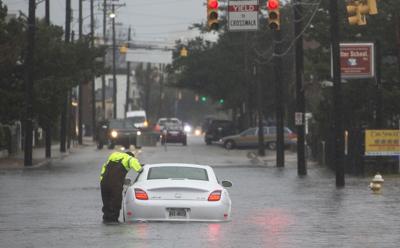At some point, there’s no “fix” for flooding whether it’s from a 1,000-year downpour or sea rise. So you have to work with what you’ve got -- at every level from households to big business and government.
That’s one of the big takeaways from Dan Goedbloed’s talk Thursday as part of Charleston’s Dutch Dialogues. It’s a given, he says, that storms intensified by climate change will occasionally overwhelm the city’s under-construction deep-tunnel pumping system. Streets will become canals and green space will become lakes -- at least until they can be pumped out at low tide. But we can learn to live with it and, over time, reduce the financial impact to zero in 100-year rainfall events. You read that right: no damage.
So Mr. Goedbloed, an ex-Rotterdam stormwater engineer who’s now leading Amsterdam’s Rainproof campaign, is bullish on Charleston coping with its flooding. He takes an “every raindrop counts” approach.
As far as rainfall flooding goes, the city government will need to lead the way by retaining and reusing water in parks and other public spaces. Institutions, big business and developers will need to take on projects of their own -- some radical, some mundane. Think harvesting rain for drinking water, roads that contain runoff, porous parking surfaces, retention ponds, underground storage and reuse systems.
Individuals, too, will have to take more responsibility for making their properties flood-proof. Insurance companies might even be persuaded to incentive it.
That’s asking a lot. That’s a revolution. But it’s also a solution and one the Dutch have proven is doable. And the rainbow in all of it is that these projects can make the city more beautiful, more resilient, more liveable. In Amsterdam, you wear a slicker to De Rainbar, and when it rains inside, it’s happy hour. In another part of the city, a brewer is using rain to make beer.
If fully embraced, parts of the Charleston peninsula might look completely different in 50 years. There could be canal systems in low-lying areas. The city might store and reuse vast amounts of rainwater. Most new toilets may flush with it. You want “to make a sponge out of the city,” Mr. Goedbloed says.
Different sets of solutions are being devised for specific parts of town such as the medical district as well as suburban trouble spots like the Church Creek basin and the islands.
Where to start? Everywhere and all at once. New development is the easiest to control, Mr. Goedbloed pointed out. The city and county government must demand runoff control and other flood-mitigation measures from developers, and municipalities must undertake their own flood-control projects.
Charleston may well need a “rainwater ordinance.” Rain barrels and rain gardens represent a proverbial drop-in-the-bucket, but collectively, they can make a big difference in densely populated areas. Do-it-yourselfers can get started at www. clemson.edu/extension/raingarden/. Clemson also has a wealth of information on harvesting rain water for home use, where to find rain barrels and other flood-smart projects. The Amsterdam Rainproof webpage, available in English, is https://www.rainproof.nl/.
Though the final recommendations from Dutch Dialogues won’t be ready for months – design recommendations are due Sept. 26 – it's clear that Charleston and Charlestonians must take ownership of the city’s flooding problems. City leaders and the Army Corps of Engineers must scrap for every federal dollar available for large-scale projects. Businesses big and small must do their part, individuals too. We’re getting all the tools, and it’s time to put them to work.







